When considering a new family pet, it’s important to determine if Alaskan Malamutes are good family dogs. These majestic creatures have an intimidating appearance, but don’t let that fool you. Alaskan Malamutes are known for their friendly and patient nature, making them a potential choice for families.
Alaskan Malamutes love spending time with people and are outgoing with strangers, which can make them a great fit for large families or households with regular guests. They enjoy being part of the family dynamic and thrive in social settings.
However, it’s important to establish boundaries with children. While Alaskan Malamutes are generally patient dogs, they can become grumpy if their personal space is not respected. Teaching children to understand and respect these boundaries is crucial for a harmonious coexistence.
When it comes to young children, supervision is key. Alaskan Malamutes should not be left unsupervised with young children to prevent any potential accidents. Their large size and playful nature may unintentionally cause harm to small children.
Introducing Alaskan Malamutes to other dogs requires careful consideration. Adult Malamutes may not do well with dogs of the same sex, so introducing them to a household with another dog should be approached with caution. On the other hand, introducing a Malamute puppy is often the safest option for a successful dog-to-dog introduction.
Caution is also advised when introducing Alaskan Malamutes to homes with cats or small animals. These dogs have a high prey drive and may chase and hunt small animals, including cats. Proper introductions and supervision are necessary to ensure the safety of all pets involved.
Overall, Alaskan Malamutes can make great family dogs with their friendly temperament and love for people. However, it’s important to consider their specific needs and potential challenges when introducing them into a household with other pets. With proper training, socialization, and supervision, Alaskan Malamutes can bring joy and companionship to families seeking a loyal and family-friendly dog.
Stay tuned for the following sections where we will explore the temperament of Alaskan Malamutes, their suitability for large families and households with regular guests, establishing boundaries with children, and other important considerations for successful Alaskan Malamute ownership.
Understanding the Temperament of Alaskan Malamutes
Alaskan Malamutes are known for their friendly and patient temperament, making them potential good family dogs. Despite their intimidating appearance, these gentle giants are loving and affectionate towards their human companions. They have a strong bond with their family and enjoy spending time with them, whether it’s going for long walks, playing in the backyard, or simply snuggling on the couch.
These dogs have a calm disposition, which makes them great companions for families with children. They are known for their patience and are generally tolerant of the antics and energy levels of kids. However, it is important to teach children to respect the boundaries of the Malamute and not to tease or provoke them, as all dogs have their limits.
When it comes to strangers, Alaskan Malamutes are typically friendly and outgoing. This makes them suitable for households that often have guests or large families. They are social animals and enjoy meeting new people, often greeting visitors with a wagging tail and a big smile on their face.
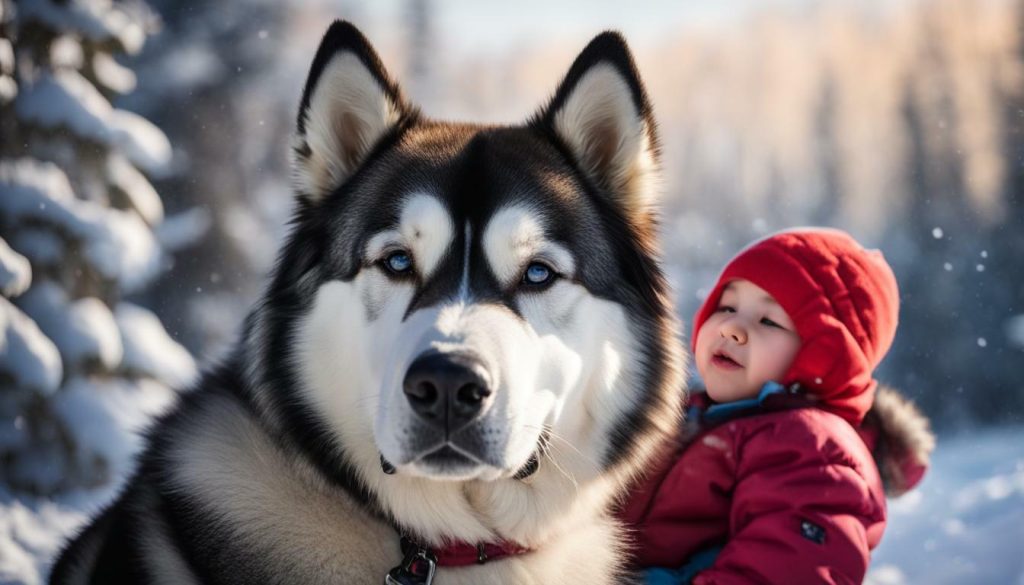
In conclusion, Alaskan Malamutes possess the ideal temperament to be excellent family dogs. Their friendly and patient nature, combined with their love for spending time with people, make them a great choice for families looking for a loyal and affectionate companion.
Suitability for Large Families and Regular Guests
Alaskan Malamutes can thrive in large families or households with regular guests, thanks to their outgoing and welcoming attitude. These gentle giants have a friendly and patient nature, making them a great fit for families looking for a furry companion. Their sociable nature means that they enjoy spending time with people and are comfortable around strangers.
When it comes to large families, Alaskan Malamutes can adapt well to the hustle and bustle of a busy household. They have a natural affinity for children and can form strong bonds with them. However, it’s important to establish boundaries and teach children to respect the personal space of the Malamute. While generally patient, these dogs can become grumpy if their boundaries are not respected.
Furthermore, Alaskan Malamutes are known for their outgoing nature and are generally comfortable with strangers. This makes them a suitable choice for households with regular guests. Whether it’s friends, relatives, or neighbors, these gentle giants are likely to welcome them with open paws.
Table: Alaskan Malamutes and Large Families
| Benefits for Large Families | Considerations for Large Families |
|---|---|
| Outgoing and friendly nature | Need for clear boundaries with children |
| Ability to form strong bonds with family members | Supervision required when interacting with young children |
| Comfortable with strangers and regular guests | Possibility of becoming grumpy if personal space is not respected |
Overall, Alaskan Malamutes have the potential to bring joy and companionship to large families or households with regular guests. Their friendly and welcoming nature, combined with their love for spending time with people, makes them a popular choice for families seeking a furry addition to their homes.
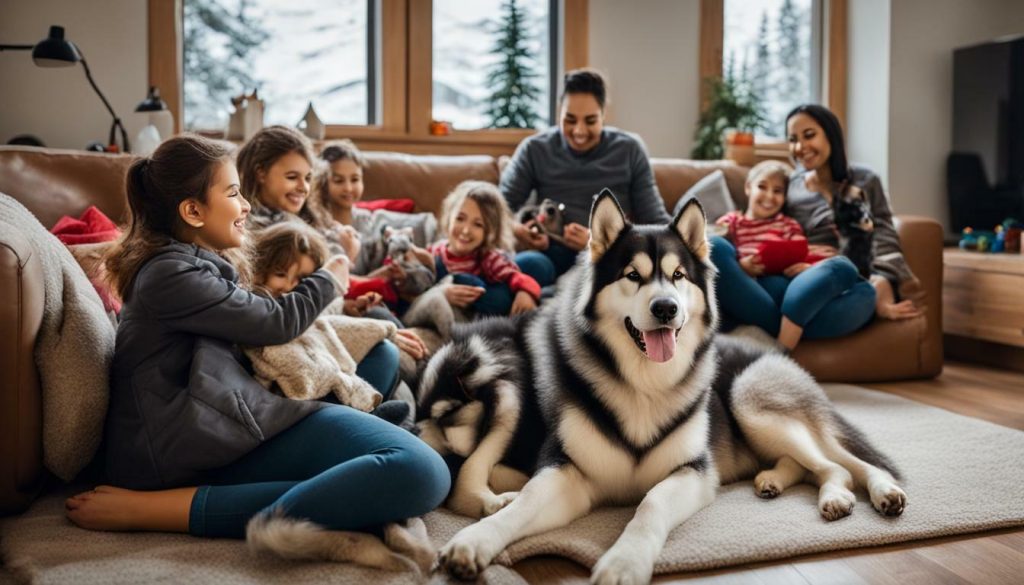
Alaskan Malamutes can make a wonderful addition to your household, whether you have a large family or welcome regular guests. With their outgoing and sociable nature, these gentle giants can thrive in a bustling and lively environment. Just remember to establish boundaries with children and ensure proper supervision when interacting with young children. By considering these factors, you can create a harmonious and loving home for both your family and your furry companion.
Establishing Boundaries with Children
It’s crucial for children to understand and respect the boundaries of Alaskan Malamutes to ensure a harmonious family environment. While these dogs are generally patient and friendly, they can become grumpy if their personal space is not respected. Teaching children how to interact appropriately with Alaskan Malamutes is essential for their safety and the well-being of the dog.
One important boundary to establish is the concept of personal space. Alaskan Malamutes, like any other dog, need their own area where they can retreat and relax. Children should be taught to give the dog space when it goes to its designated area or shows signs of wanting to be left alone. This will help prevent the dog from feeling overwhelmed or stressed.
Additionally, children should be educated on how to approach and pet an Alaskan Malamute gently and calmly. They should avoid sudden movements, loud noises, or rough play that may startle or irritate the dog. Supervision is crucial during interactions between children and dogs to ensure that both parties are behaving appropriately.
The importance of dog training
Dog training is vital in establishing boundaries and creating a positive relationship between children and Alaskan Malamutes. It teaches the dog basic commands, such as sit, stay, and leave it, which can be used to redirect any unwanted behavior. Training can also help children understand how to communicate with the dog effectively and interpret its body language.
“Training is not only about teaching the dog; it’s also about teaching children how to interact safely and respectfully with their furry friend.”
By involving children in the training process, they can develop a better understanding of the dog’s needs and boundaries. Positive reinforcement methods, such as rewards and praise, can be used to encourage both the dog and the child to engage in desired behaviors. This promotes a sense of teamwork and strengthens the bond between them.
| Training Tips for Children |
|---|
| Always supervise interactions between children and Alaskan Malamutes |
| Teach children to ask permission before approaching the dog |
| Encourage children to use a calm and gentle tone of voice around the dog |
| Teach children to avoid pulling on the dog’s ears, tail, or fur |
| Reinforce positive behaviors with rewards and praise |
| Provide children with clear instructions on how to interact with the dog |
By establishing and reinforcing boundaries with children, Alaskan Malamutes can thrive in a family environment and establish a strong bond with their human companions.
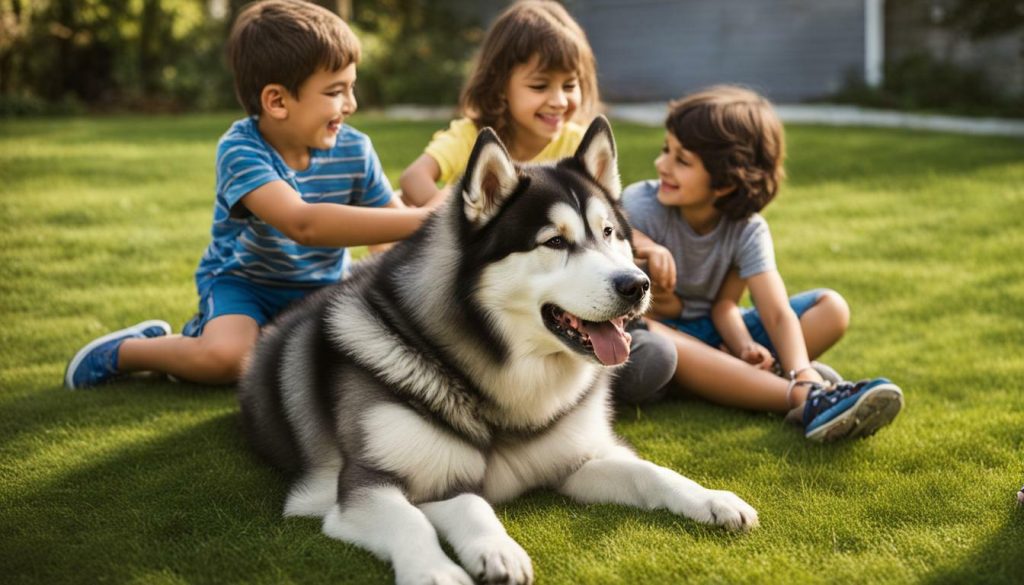
When introducing Alaskan Malamutes to a household with young children, supervision is essential to ensure the safety of both the children and the dogs. While Alaskan Malamutes are generally patient and gentle, any interaction between dogs and young children should be closely monitored to prevent any potential accidents. Their large size and strength can inadvertently cause harm if they are not properly managed.
It’s important to teach children how to interact respectfully with Alaskan Malamutes and to recognize their boundaries. They should be taught not to pull on their ears or tail, climb on them, or disturb them while they are eating or resting. Alaskan Malamutes, like any other dog breed, need their personal space and should not be crowded or overwhelmed by young children.
| Tips for Supervision and Safety |
|---|
| 1. Always have an adult present when young children and Alaskan Malamutes are together. |
| 2. Teach children how to behave around dogs, including respecting their boundaries. |
| 3. Avoid leaving young children and Alaskan Malamutes unsupervised. |
| 4. Provide a safe space for the dog to retreat to when they need time alone. |
By implementing these safety measures, families can enjoy the companionship of an Alaskan Malamute while ensuring the well-being of both the dog and the children. With proper supervision and education, Alaskan Malamutes can thrive in a family environment and form strong bonds with their human counterparts.
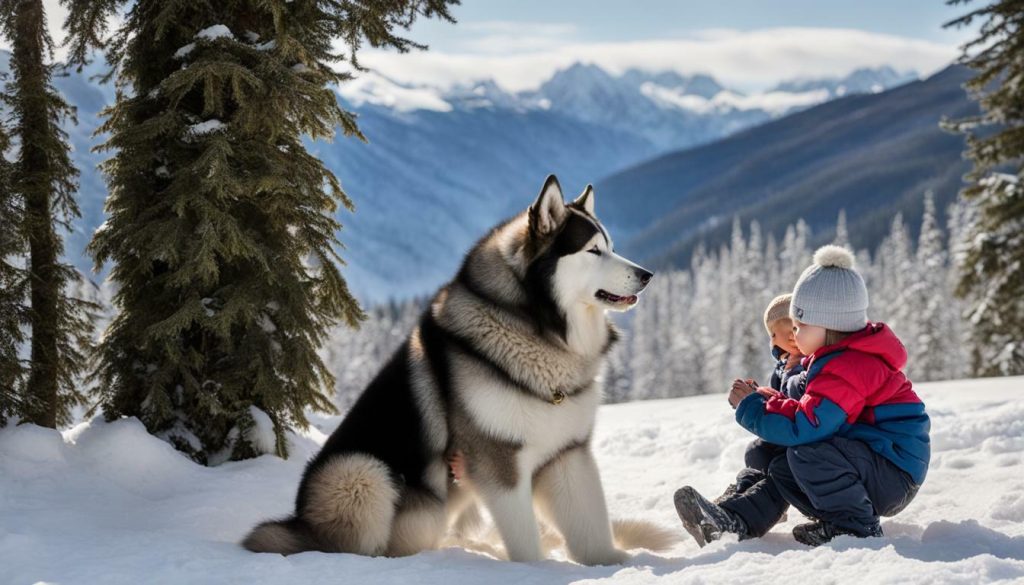
Supervision is crucial when introducing Alaskan Malamutes to households with young children. Their interactions should always be closely monitored to prevent any accidents. Teaching children to respect the boundaries of Alaskan Malamutes and providing them with a safe space are essential. Following these tips for supervision and safety will help families enjoy the company of an Alaskan Malamute while ensuring the well-being of both the children and the dogs.
Introducing Alaskan Malamutes to Other Dogs
Introducing Alaskan Malamutes to other dogs requires careful consideration, as adult Malamutes may not get along with dogs of the same sex. While they are generally sociable and friendly, their independent nature and strong pack instincts can sometimes lead to conflicts. It is recommended to introduce a Malamute puppy instead, as they are more adaptable and open to forming new relationships.
When introducing adult Malamutes to other dogs, it is important to follow a gradual and supervised process. Start by allowing them to meet in a neutral, controlled environment, such as a park or a fenced backyard. Keep both dogs on a leash during the initial meeting and observe their body language closely. Look for signs of tension or aggression, such as raised hackles, growling, or excessive dominance posturing.
If the initial interaction goes well, you can gradually increase the duration and proximity of their meetings. Continue to monitor their behavior and intervene if any signs of aggression or discomfort arise. It is essential to provide positive reinforcement and rewards when they display friendly and calm behavior towards each other.
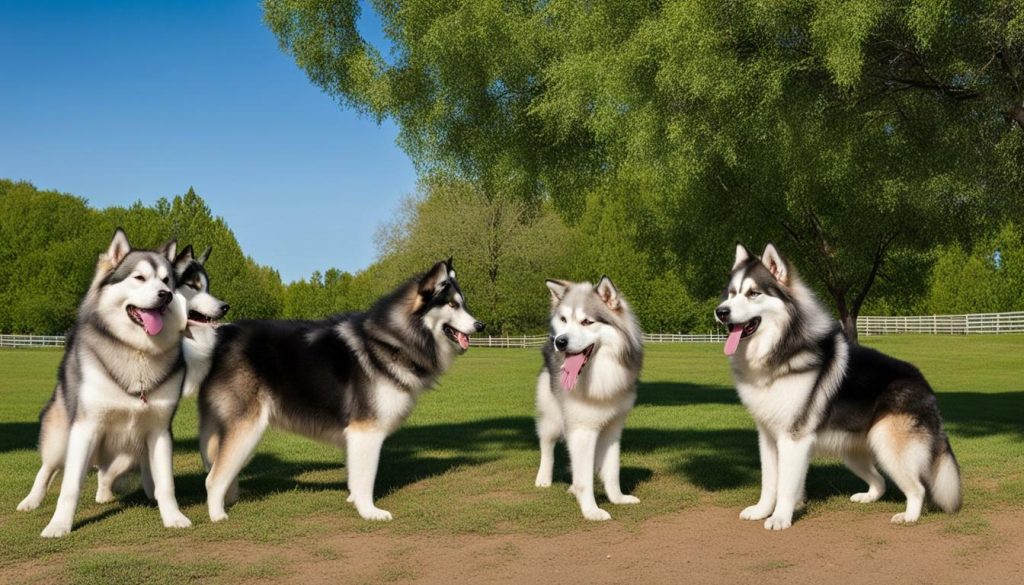
Remember that every dog is unique, and individual personalities and temperaments can greatly influence the outcome of their interactions. If you are unsure about introducing your Alaskan Malamute to another dog, it is always best to consult with a professional dog trainer or behaviorist who can provide guidance and support throughout the process.
Introducing Alaskan Malamutes to Other Dogs – Tips for Success
| Tip | Description |
|---|---|
| Start with a neutral introduction | Choose a neutral location for the first meeting to avoid territorial issues. |
| Keep both dogs on a leash | Leashes provide control and allow you to intervene if necessary. |
| Monitor body language | Watch for any signs of tension, aggression, or discomfort. |
| Use positive reinforcement | Reward calm and friendly behavior with treats and praise. |
| Take it slow | Gradually increase the duration and proximity of their interactions. |
| Seek professional guidance | If you are unsure or encounter difficulties, consult a professional dog trainer or behaviorist. |
By following these tips and guidelines, you can increase the chances of a successful introduction between your Alaskan Malamute and another dog. With patience, supervision, and positive reinforcement, your Malamute can develop healthy and harmonious relationships with canine companions.
Caution with Cats and Small Animals
Alaskan Malamutes have a natural prey drive, so it’s important to exercise caution when introducing them to homes with cats or small animals. Their instincts as working sled dogs make them prone to chasing and hunting smaller creatures. While every dog is unique, it’s crucial to carefully manage their interactions with other household pets to ensure everyone’s safety and well-being.
To minimize potential conflicts, it’s recommended to introduce Alaskan Malamutes to cats or small animals gradually and under controlled circumstances. A gradual introduction will allow them to become familiar with the new additions and reduce the likelihood of triggering their prey drive. Supervision is essential during the early stages of interaction to prevent any harm coming to the smaller pets.
Creating a safe space for the smaller pets, such as separate rooms or using baby gates, can help them feel secure and provide a controlled environment for initial introductions. Slowly allowing supervised interactions under controlled circumstances will allow for a better understanding between the Alaskan Malamute and the smaller animals.
| Tips for Introducing Alaskan Malamutes to Cats and Small Animals: |
|---|
| 1. Start with scent exchanges: Allow the pets to get familiar with each other’s scents by exchanging bedding or using pheromone diffusers. |
| 2. Supervised introductions: Keep the Malamute on a leash and have the smaller pet in a secure enclosure. Observe their behavior closely, ensuring the Malamute remains calm and not overly fixated on the smaller pet. |
| 3. Reward positive behavior: Praise and reward the Alaskan Malamute for calm and gentle interactions with the smaller pet. This will reinforce positive behavior and help create a harmonious environment. |
| 4. Separate feeding areas: Ensure separate feeding areas for the Alaskan Malamute and the smaller pet to avoid any potential resource guarding or conflicts. |
| 5. Seek professional guidance if needed: If you encounter challenges or concerns during the introduction process, consult with a professional dog trainer or animal behaviorist who can provide expert guidance tailored to your specific circumstances. |
No two situations are exactly alike, so it’s important to assess each individual Alaskan Malamute’s behavior and reactions during the introduction process. Patience, consistency, and positive reinforcement training techniques can help establish a peaceful coexistence between your Alaskan Malamute and your existing pets.

Alaskan Malamutes can make great family dogs, but it’s important to consider their specific needs and potential challenges when introducing them into a household. These majestic dogs may have an intimidating appearance, but beneath their tough exterior, they possess a friendly and patient nature that can make them wonderful companions for families.
One of the key traits that make Alaskan Malamutes suitable for families is their love for spending time with people. They thrive on human companionship and enjoy being included in family activities. Their outgoing nature also makes them a good fit for households with regular guests, as they are comfortable with strangers and often greet visitors with enthusiasm.
However, it’s essential to establish boundaries with Alaskan Malamutes, especially when there are children in the household. While these dogs are generally patient and tolerant, they can become grumpy if their personal space is not respected. Teaching children to be respectful and gentle with the Malamute is crucial to maintaining a harmonious relationship between the dog and the family.
| Living with Other Dogs | Introducing Cats and Small Animals |
|---|---|
| When it comes to living with other dogs, it’s important to note that adult Malamutes may not do well with dogs of the same sex. If you already have a dog in the household, it’s advisable to introduce a Malamute puppy to ensure better compatibility and reduce the chances of conflicts. | Alaskan Malamutes have a high prey drive and may instinctively chase and hunt small animals. Therefore, caution is advised when introducing them to a home with cats or other small animals. Proper introductions and supervised interactions are crucial to creating a safe and harmonious environment for all pets. |
Overall, with the right training, socialization, and care, Alaskan Malamutes can be excellent family dogs. They offer loyalty, companionship, and a unique sense of adventure. However, it’s important to remember their independent nature and potential challenges when introducing them into a household. By understanding their specific needs and providing them with a loving and structured environment, Alaskan Malamutes can thrive as cherished members of the family.
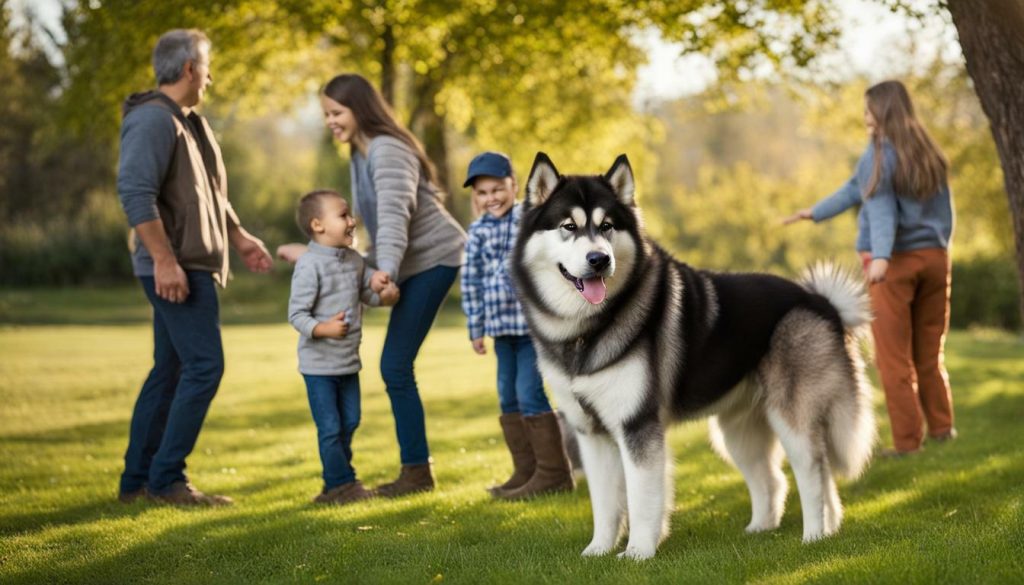
Here are some practical tips to ensure a successful and fulfilling relationship with your Alaskan Malamute:
“Consistent training is essential for Alaskan Malamutes. They are intelligent dogs, but their independent nature can sometimes result in stubbornness. Positive reinforcement techniques, such as rewards and praise, work best in motivating and shaping their behavior.”
“Provide plenty of physical and mental stimulation for your Malamute. They are an active breed and need regular exercise to stay happy and healthy. Interactive toys, puzzle games, and daily walks or runs can help meet their energy needs.”
“Socialize your Alaskan Malamute from a young age. Expose them to various environments, people, and other dogs to help them develop good manners and adaptability. Early socialization is crucial in preventing behavioral issues later in life.”
“Create a safe and comfortable space for your Malamute, where they can retreat and relax. Providing a designated area with their bed, toys, and water bowl allows them to have their own space and helps prevent any potential possessiveness.”
By following these tips and providing the necessary love, care, and attention, you can enjoy a fulfilling and rewarding relationship with your Alaskan Malamute, making them an invaluable addition to your family.
Conclusion
In conclusion, Alaskan Malamutes can be good family dogs, but they require careful consideration and proper management to ensure a harmonious home environment. Despite their intimidating appearance, these dogs are friendly and patient, making them a potential choice for families. They have a love for spending time with people and are outgoing with strangers, which means they can easily fit into large families or households with regular guests.
However, it is important to establish boundaries with children and teach them to respect the personal space of Alaskan Malamutes. While these dogs are generally patient, they can become grumpy if their boundaries are not respected. Supervision is also key when it comes to young children, as they should not be left unsupervised with Alaskan Malamutes to prevent any potential accidents.
When introducing Alaskan Malamutes to other dogs, it is best to avoid introducing them to a household with another dog of the same sex, as adult Malamutes may not do well in such situations. On the other hand, introducing a Malamute puppy is a safer option. Caution is also advised when introducing Alaskan Malamutes to homes with cats or small animals, as they have a high prey drive and may chase or hunt them.
Overall, Alaskan Malamutes can make great family dogs, but extra consideration is needed when introducing them into a household with other pets. With proper training, socialization, and supervision, they can bring joy and companionship to families who understand their unique needs and are willing to provide them with a loving and structured home environment.
| Pros | Cons |
|---|---|
| Friendly and patient | Requires careful management |
| Outgoing with strangers | Can become grumpy if boundaries are not respected |
| Suitable for large families | Needs supervision with young children |
| Can be introduced to other dogs (preferably a Malamute puppy) | Not recommended to be introduced to a household with another dog of the same sex |
| May chase and hunt small animals | Caution needed when introducing them to homes with cats or small animals |
“Alaskan Malamutes can bring joy and companionship to families who understand their unique needs and are willing to provide them with a loving and structured home environment.”
Tips for Successful Alaskan Malamute Ownership
Owning an Alaskan Malamute as a family pet can be a rewarding experience with the right approach and care. These majestic dogs require proper training, exercise, and socialization to thrive in a family environment. Here are some tips to ensure a successful Alaskan Malamute ownership:
1. Start Training Early
Begin training your Alaskan Malamute puppy as soon as you bring them home. Positive reinforcement methods work best with this breed, as they respond well to rewards and praise. Teach them basic commands like sit, stay, and come, and gradually introduce more advanced training exercises. Consistency and patience are key to molding your Alaskan Malamute into a well-behaved family companion.
2. Provide Sufficient Exercise
Alaskan Malamutes are active dogs that require regular exercise to maintain their physical and mental well-being. Engage in daily walks, runs, or play sessions with your furry friend to fulfill their exercise needs. A tired Alaskan Malamute is generally a well-behaved one, so make sure to provide ample opportunities for them to burn off energy.
3. Socialize Your Malamute
Proper socialization is crucial for Alaskan Malamutes to become well-adjusted family pets. Expose them to various people, animals, and environments from an early age. Arrange playdates with friendly dogs, introduce them to new sights and sounds, and allow them to interact with different individuals. This will help them develop good social skills and prevent behavioral issues in the future.
“Consistency and patience are key to molding your Alaskan Malamute into a well-behaved family companion.”
Remember, owning an Alaskan Malamute requires commitment and dedication. These dogs thrive in a loving and structured environment where their physical and emotional needs are met. By following these tips, you can ensure a harmonious and fulfilling relationship with your Alaskan Malamute as a beloved family member.

| Tips for Successful Alaskan Malamute Ownership |
|---|
| Start training early |
| Provide sufficient exercise |
| Socialize your Malamute |
Exploring Other Family-Friendly Dog Breeds
If Alaskan Malamutes don’t seem like the right fit for your family, there are other dog breeds known for their suitability as family pets. These breeds offer different characteristics and temperaments that may better suit your household’s needs.
Labrador Retrievers are a popular choice for families due to their friendly, outgoing nature. They are known for their patience with children and their ability to get along well with other animals. Labs are also highly trainable and make excellent companions for outdoor activities.
Golden Retrievers are another family-friendly breed that is known for their gentle and affectionate nature. They are great with children of all ages and are eager to please their owners. Goldens are versatile dogs that excel in various activities, from obedience training to therapy work.
If you prefer a smaller breed, consider the Cavalier King Charles Spaniel. These dogs are known for their loving and gentle demeanor, making them ideal for families with young children. Cavaliers are highly adaptable and can thrive in both apartments and larger homes.
The Beagle is a popular choice for families looking for an energetic and fun-loving pet. They are known for their playful nature and get along well with children and other dogs. Beagles are curious and active, so they require regular exercise and mental stimulation.
Remember, when choosing a family dog, it’s important to consider your lifestyle, living arrangements, and the needs of your family members. Researching different breeds and their specific traits can help you find the perfect companion for your family.
FAQ
Q: Are Alaskan Malamutes good family dogs?
A: Yes, Alaskan Malamutes can make great family dogs if they are in the right household.
Q: Do Alaskan Malamutes get along well with children?
A: Alaskan Malamutes can be introduced to families with children, but supervision is necessary, and they should not be left unsupervised with young children.
Q: Can Alaskan Malamutes live with other dogs?
A: Adult Malamutes should not be introduced to a household with another dog of the same sex, while introducing a Malamute puppy is the safest option.
Q: Can Alaskan Malamutes live with cats?
A: Caution is advised when introducing Alaskan Malamutes to a home with cats or other small animals due to their high prey drive.
Q: What are some tips for successful Alaskan Malamute ownership?
A: Some tips for successful Alaskan Malamute ownership include proper training, exercise, and socialization.
Q: Are there other family-friendly dog breeds to consider?
A: Yes, there are several other dog breeds known for being good family dogs, providing additional options for those seeking a family-friendly pet.
